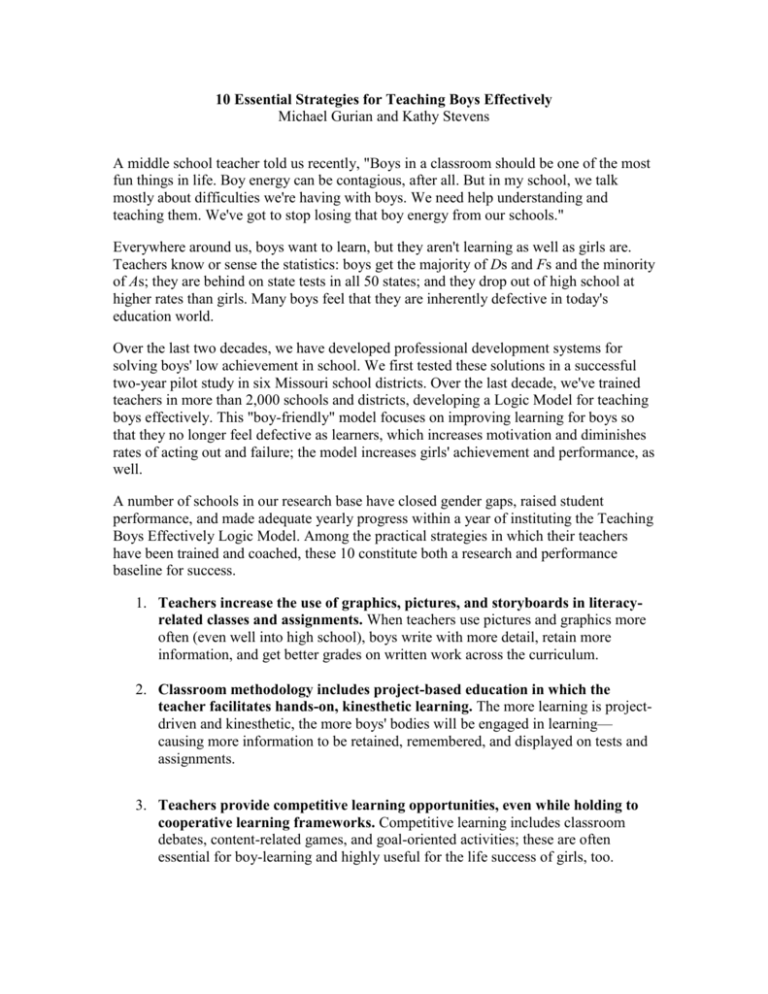
10 Essential Strategies for Teaching Boys Effectively
Michael Gurian and Kathy Stevens
A middle school teacher told us recently, "Boys in a classroom should be one of the most
fun things in life. Boy energy can be contagious, after all. But in my school, we talk
mostly about difficulties we're having with boys. We need help understanding and
teaching them. We've got to stop losing that boy energy from our schools."
Everywhere around us, boys want to learn, but they aren't learning as well as girls are.
Teachers know or sense the statistics: boys get the majority of Ds and Fs and the minority
of As; they are behind on state tests in all 50 states; and they drop out of high school at
higher rates than girls. Many boys feel that they are inherently defective in today's
education world.
Over the last two decades, we have developed professional development systems for
solving boys' low achievement in school. We first tested these solutions in a successful
two-year pilot study in six Missouri school districts. Over the last decade, we've trained
teachers in more than 2,000 schools and districts, developing a Logic Model for teaching
boys effectively. This "boy-friendly" model focuses on improving learning for boys so
that they no longer feel defective as learners, which increases motivation and diminishes
rates of acting out and failure; the model increases girls' achievement and performance, as
well.
A number of schools in our research base have closed gender gaps, raised student
performance, and made adequate yearly progress within a year of instituting the Teaching
Boys Effectively Logic Model. Among the practical strategies in which their teachers
have been trained and coached, these 10 constitute both a research and performance
baseline for success.
1. Teachers increase the use of graphics, pictures, and storyboards in literacyrelated classes and assignments. When teachers use pictures and graphics more
often (even well into high school), boys write with more detail, retain more
information, and get better grades on written work across the curriculum.
2. Classroom methodology includes project-based education in which the
teacher facilitates hands-on, kinesthetic learning. The more learning is projectdriven and kinesthetic, the more boys' bodies will be engaged in learning—
causing more information to be retained, remembered, and displayed on tests and
assignments.
3. Teachers provide competitive learning opportunities, even while holding to
cooperative learning frameworks. Competitive learning includes classroom
debates, content-related games, and goal-oriented activities; these are often
essential for boy-learning and highly useful for the life success of girls, too.
4. Classroom curricula include skills training in time, homework, and
classroom management. In order to feel competent, engaged, and motivated,
many boys need help learning how to do homework, follow directions, and
succeed in school and life; classrooms are the primary place these boys come for
that training.
5. Approximately 50 percent of reading and writing choices in a classroom are
left up to the students themselves. Regularly including nontraditional materials,
such as graphic novels, magazines, and comic books, increases boys' engagement
in reading and improves both creative and expository writing.
6. Teachers move around their classrooms as they teach. Instructors' physical
movement increases boys' engagement, and includes the teacher leading students
in physical "brain breaks"—quick, one-minute brain-awakening activities—that
keep boys' minds engaged.
7. Students are allowed to move around as needed in classrooms, and they are
taught how to practice self-discipline in their movement. This strategy is
especially useful when male students are reading or writing—when certain boys
twitch, tap their feet, stand up, or pace, they are often learning better than if they
sit still, but teachers are often not trained in innovating toward more movement in
classrooms.
8. Male mentoring systems permeate the school culture, including use of
parent-mentors, male teachers, vertical mentoring (e.g., high school students
mentoring elementary students), and male peer mentoring. By 16,
vocationally oriented boys (and girls) need schools and communities to provide
access to jobs and mentors through which students can master a trade.
9. Teachers use boys-only (and girls-only) group work and discussion groups in
core classes such as language arts, math, science, and technology. Some boys
and girls who do not flourish in the busyness or social distraction of coed classes
get a chance to flourish in new ways in single-sex groupings.
10. Teachers and counselors provide skill building for sensitive boys
(approximately 20 percent of males fall somewhere on the "sensitive boy"
spectrum), and special education classes are taught by teachers trained in
how to teach boys specifically. This is crucial because approximately 70 percent
of learning-disabled students nationwide are boys.
In all gender initiatives in which we and our team are involved, we encourage schools
and districts to conduct parent involvement sessions so that parents can work together
with teachers. Research-driven, science-based, and strategies-focused innovations need
teamwork from everyone, including the students themselves. The alienation of boys in
our classrooms is not a one-teacher issue: it is a problem in education culture as a whole,
and a problem for which there are specific solutions.
Boys are wonderful learners and can learn as well as girls. Through the disruptions they
cause in classrooms and the low grades they get on report cards, through their glazed eyes
and tapping feet, through their aggression or confusion on the playground, they are
pleading: "We need a lot of help. We need teachers to understand how to teach us
effectively, so that we succeed. We need schools to harness and challenge our powerful
energy. We need everyone to remember: we're not just 'kids' or 'students'—we are boys."
Michael Gurian is the author of Boys and Girls Learn Differently and The Mind of Boys
and founder of the Gurian Institute. Kathy Stevens is training director of the Gurian
Institute, author of Strategies for Teaching Boys and Girls, and coauthor of The Mind of
Boys.
ASCD Express, Vol. 6, No. 4. Copyright 2010 by ASCD. All rights reserved. Visit
www.ascd.org/ascdexpress.










